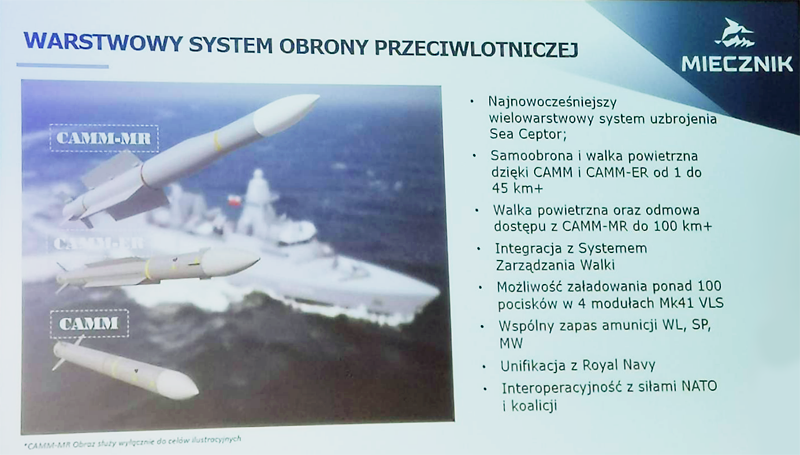More detail on the UK/Poland Future Common Missile (CAMM-MR)
Range well in excess of 100km (>54nm) and engagement altitude >20km (>65,000ft) is getting into Patriot territory.
View: https://twitter.com/Gabriel64869839/status/1688845063055360000
Article Text from radar.rp.pl - re-tweeted by MBDA Poland - Translation by Google Translate
https://radar.rp.pl/przemysl-obronny/art38914121-dalekosiezny-pocisk-powiekszy-rodzine-rakiet-camm
The long-range missile will expand the CAMM missile family
The family of British anti-aircraft radar-guided CAMM missiles will probably see the new CAMM-MR missile with a range well in excess of 100 km. MBDA UK confirms: preparations have started.
The start of analyzes and conceptual work aimed at the production of weapons more powerful than the current CAMM (Common Anti-air Modular Missile) and CAMM-ER missiles was announced to journalists from Poland by the heads of MBDA UK during last week's visit to the facilities in Bolton near Manchester. Adrian Monks, director of MBDA UK for business development in Poland, emphasized that inspiration for British constructors also comes from partners from the East:
Warsaw is very keen to have a missile in the future that uses proven and effective solutions of CAMM missiles, but it could hit targets at a greater distance than, for example, the ER version missile offered for the future "Narew" air shield, operating at a distance of about 45 km - he explains monks.
Necessary changes to the launcher
The analyzes of MBDA UK specialists show that the future long-range missile bearing the MR mark would be a new design with a mass much greater than the current, not exceeding 99 kg, classic CAMM effectors. Due to the larger dimensions of the new weapon, the structure of the iLouncher launcher would also be rebuilt - instead of 4 containers with missiles, the launch container would contain one CAMM MR missile.
There is a discussion among specialists whether to extend the range of the weapon, a special booster should be used in the propulsion system to increase the thrust.
These other decisions and decisions regarding the design of the missile are still before MBDA specialists - says Monks. - However, it is clear what we intend to achieve: the target is missiles with a range well over 100 km and capable of reaching a ceiling of about 20 km - he adds.
The British emphasize that it is very important, especially in the light of the war experience in Ukraine, to preserve all the advantages and capabilities of CAMM family effectors in the future CAMM-MR design. The unique cold-start technique of missiles makes it much easier, for example, to mask positions and hide launchers deployed in the field, experts say.
The great career of anti-aircraft missiles
Let's remind. Radar-guided CAMM (Common Anti-Air Modular Missiles) missiles, which initially protected Royal Navy ships as a deck weapon, are now making a rapid career in ground-based anti-aircraft systems of the British and Italian armies.
CAMM missiles are very precise weapons capable of engaging fast targets such as cruise missiles and aircraft. In addition, it is extremely effective in destroying enemy combat drones.
The CAMM system is multi-channel, which means that it is able to track and fight a dozen or more targets at the same time. A single radar-guided CAMM missile weighing less than 1 ton can reach a speed of 3700 km/h and destroy fighters, unmanned aerial vehicles and even laser-guided precision bombs. CAMM/CAMM-ER are the only Western anti-aircraft missiles that use the so-called cold start.
Discreet and concealed pneumatic start
The CAMM rocket is first launched from the launch container by means of a pneumatic catapult, then its miniature rocket thrusters are activated, turning the missile towards the target, and only then the rocket thruster is activated. Thanks to this, the position of the launcher is difficult to detect, because the launch of missiles in the first phase of flight is not accompanied by a blast and fire of muzzle gases. In addition, the rockets are fired from vertical launchers, which shortens the reaction time and increases the ability to engage targets in a full 360-degree range. In addition, the rocket engine of the CAMM missiles uses the so-called insensitive fuel with the highest degree of security in this class of weapons.
According to Polish experts, CAMM and CAMM-ER anti-aircraft systems are currently among the most effective in NATO countries. The missiles are equipped with an active jamming-resistant radar guidance system. Also Polish elements of the missile set are introduced to the top technological shelf.
According to MBDA UK, future long-range CAMM MR missiles, the development of which is just beginning, could reach the state of operational readiness and supply allied arsenals only in the early 2030s.






